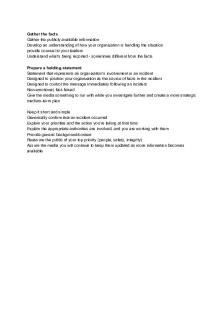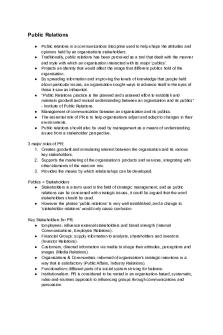Pr marketing notes PDF

| Title | Pr marketing notes |
|---|---|
| Course | Principles of Marketing |
| Institution | The University of Notre Dame (Australia) |
| Pages | 29 |
| File Size | 593.6 KB |
| File Type | |
| Total Downloads | 80 |
| Total Views | 528 |
Summary
Lecture 1 notes Principles of Marketing.Marketing: an organizational function and set of processes for creating, communicating and delivering value to customers and beneficially managing customer relaionships.Marketing strategy:Every marketing scheme should have a plan that includes:The planning pha...
Description
Lecture 1 notes Principles of Marketing.
Marketing: an organizational function and set of processes for creating, communicating and delivering value to customers and beneficially managing customer relaionships.
Marketing strategy: Every marketing scheme should have a plan that includes: The planning phase: -
Step 1: business mission and objectives Step 2: situation analysis (SWOT)
The implementation phase: -
Step 3: identify opportunities (segmentation, targeting and positioning) Step 4: implement marketing mix (product, price, place and promotion)
The control phase: -
Step 5: Evaluate performance using marketing metrics
Core aspects of marketing: -
Marketing helps create value Marketing occurs in many settings Marketing can be performed by both individuals and organisations Marketing is about satisfying customer needs and wants Marketing entails an exchange Marketing requires product, price, place and promotion decisions
Good marketing targets potential customers who: - have an interest in the offering - have the ability to buy it
4P’s of marketing: -
Promotion: communicating value Product: creating value Place: delivering value Price: capturing value
Supply chain management: processes necessary to get the product to customer at R time and place
Promotion: communication by a marketer that informs, persuades and reminds potential buyers about a product, service or idea to in fluence their opinions or elicit a response
Eras of marketing -
1900-20: production 1920-50: sales 1950-90: marketing 1990-present: value based marketing
Consumer elements: balance of power has shifted from marketer to consumer due to: a. Transparency of information b. Ubiquity of choice
Transparency of information: -
Consumers have unprecedented access to information regarding products, prices and competition. Active consumers influence brand perceptions through blogs and reviews
Electronic word of mouth: - allows consumers to engage with other consumers (e.g reviews)
Digital channels: websites and social media, search engines, email, mobile phones Big data: data from social media to a company regarding consumers
The 4E framework for social media marketing: Excite: through relevant offering (insights from s.m) Educate: communicated through value Experience: simulate product trial (e.g youtube unboxing and demos) ↓↓↓ Engage the customers -
Listening and responding via social media sites Involving customers particularly opinion leaders Empowerment, consumers answering other consumers questions (notion of co-creation)
Engagement leads to increased loyalty, commitment and profitability
Lecture 2 notes
SWOT: things that face the company -
Strengths Weaknesses Opportunities Threats
Marketing environment analysis framework:
Immediate environment: consists of company, competition and corporate partners surrounding the consumers -
Strengths and weaknesses of company and competitors Calculate market share
Culture: shared meanings, beliefs, morals, values and customs of a group of people Country culture: perceptible nuances such as behaviour, dress codes, ceremonies, language, food preferences Regional culture: the culture of the particular region in which people live
Demographics: easy to understand snapshot of the typical consumer in a target market
Big 5 Social trends 1. -
Thrift: Impact of the gfc: price sensitivity (consumers more wary of spent money) Consumer research prior to purchases Opportunities for businesses for increased market share as a result of money saving
2. Health and wellness: - Government initiatives to reduce healthcare costs - Increasing focus on health and lifestyle changes
3. -
Greener consumers: Government and competitive pressure Some segments are willing to pay a small premium to be green Opportunities for differentiation: energy saving household appliances, low emission vehicles, using recycled materials
4. Privacy concerns: - Marketers depend on data to offer more personalized experiences online - Disputes over consent, how info is collected, how it is stored and shared
5. Time-poor society - Average hours worked per week declining in Australia - Businesses give the impression that customers now have more control over how they manage their time - Devices such as tap and go, self checkout, ubereats all for time saving
Technological advances: -
Advances in technology have changed many traditional industries Challenge for firms to use technology to create and enhance the value proposition Value = what you get/what you give
Economic situation: -
Economy affects what consumers buy and how they spend money (foreign exchange rates affect imports and tourism
Political/legal environment: -
Australian competition and consumer commission imposes heavy penalties on anticompetitive practises such as price fixing and collusion
-
Legislation protects consumers from: misleading advertisements, harmful materials
General knowledge: -
Everything a firm does should revolve around the customer Demographics and generational characteristics help marketers to segment the market The challenge for technological advances is how they can help increase value Social factors such as thrift, health, green marketing, concerns for privacy and a time-poor society will affect what consumers purchase and consume.
Lecture 3
Consumer buying behaviour: refers to the buying behaviour of final customers who buy goods and services for personal consumption. It is studied to answer how do consumers respond to marketing efforts the company might use?
Factors affecting consumer behaviour: psychological factors: -
motivation: pressing needs that require satisfaction learning: past experiences with a product or brand beliefs and attitudes: may be based on real knowledge, opinion, or faith e.g good quality Perception: selective attention/distortion/retention Selective attention: tend to screen out info Selective distortion: tend to interpret info to support what you believe Selective retention: tend to retain info that support what you believe
Maslows hierarchy of needs 1. Physiological needs (hunger, thurst) 2. Safety needs (security, protection) 3. Social needs (sense of belonging, love) 4. Esteem needs (self-esteem) 5. Self-actualization (self development)
Social factors: Groups: membership: -
Primary (more interaction) Secondary (less interaction)
Reference: -
Aspirational group
Family: -
Husband, wife, kids Generically an influencer, buyer, initiator and decider
Social roles and status: -
People tend to buy products that reflect their position/status in society
Situational factors: -
Purchasing situation e.g store only accepts cash Shopping situation e.g store atmosphere, well-trained sales people, in-store promotions Temporal states: what mood customer is in at certain time e.g people overspend at supermarket when hungry
Types of buying decisions: -
extended problem solving: buying decision that calls for a lot of effort and time limited problem solving: requires little to moderate amount of effort and time impulse buying: buying decision made on the spot when you see the product habitual decision making: consumers engage little conscious effort
The consumer decision process: 1. Need recognition: difference between an actual and a desired state Internal stimuli: hunger, thirst External stimuli: marketers aim to highlight unsatisfied needs or desired states Consumer needs can be: Functional: buy clothes to cover body Psychological: buy designer clothes because they inspire confidence
2. search for information: regarding product Internal search: referring to consumers memories or past knowledge External search: consumers refers to friends, family and other commercial exposure -
media and marketing skepticism (importance of credibility)
types of risk that can discourage a purchase: -
performance risk: risk of a poorly performing product financial risk: associated with high cost of the purchase social risk: what others think about your purchase
-
physiological risk: risk to personal safety when using the wrong (cheaper) product psychological risks: risk that you may not feel comfortable or happy using the product
3. evaluation of alternatives: comprised of a universal set, retrieval set and evoked set of brands you would consider purchasing -
product attributes: evaluation of quality, price and other features degree of importance: which attributes matter most to me brand beliefs: what do I believe about each available brand? Expected product satisfaction: how satisfied would I be with the product Evaluation procedures: choosing a product based on a variety of attributes (USP unique selling proposition – this is why you should buy me)
Consumer decision rules: the information processing strategies of consumers are called decision rules. Can be classified as either compensatory or non-compensatory -
Compensatory: to trade one product attribute against another, such that strong attributes compensate for weak attributes Non-compensatory: buyer makes a decision from only one or a small number of product attributes. Strong attributes do not compensate for weak attributes
Strategies for marketers: -
Modify product to meet consumer preferences Persuade buyers to attach more weight to what your product thrives in Shift the buyers ideals e.g faster is not better
4. purchase and consumption: the purchase stage of the process
5. post purchase stage: how satisfied and successful was the exchange: customer satisfaction: the difference between expectations of performance and perceived performance. Steps taken to ensure customer satisfaction: demonstration of correct product use encouraging feedback periodically making contact with customers after sales service/warranty
post purchase dissonance: when a customer questions the appropriateness of a purchase they have made. -
Likely to occur in relation to products that are expensive, infrequently purchased, risky products Can be triggered by mixed signals from friends and family about their decision to buy Warranties and guarantees help minimise postpurchase dissonance
Customer loyalty: opportunity to solidify relationship with customer, so as to achieve repeat purchase -
Loyal customers only buy certain brands, at certain stores, and include no other brands in their evoked set Behavioural loyalty: loyal due to loyalty program Attitudinal loyalty: falling in love with the brand or product
Lecture 4
Segmentation, targeting and positioning processes
Step 1: establish overall strategy or objectives -
What segments to serve must be consistent with the firms mission statement and be based on the current assessments from SWOT analysis Identifying potentially large and profitable markets, before competitors do, is an opportunity
Step 2: segmentation methods: geographic: where someone is situated demographic: age, gender, income psychographic: lifestyle, self-concept, self values benefits: convenience, economy, prestige behavioural: usage, loyalty
Geographic and demographic segmentation: Geographic: dividing customers on the basis of where they live Demographic: dividing customers based on age, gender, income and education
Psychographic segmentation: -
Dividing your market based on consumers personality traits, values, attitudes, interests and lifestyles More precise match between the product and each segments needs and wants
Values and lifestyle classification -
Abundant resources: innovators People oriented (idealised criteria): thinkers – believers Status oriented (opinion of others): achievers – strivers Action oriented (activity and variety): experiencers – makers
-
Minimal resources: survivors
Benefit segmentation: divides consumers on the basis of product benefits and enables marketers to use specific products to satisfy specific needs -
Divides consumers into segments on the basis of usage occasion, usage rate, and loyalty
Online behavioural segmentation: based on a customers past and current shopping behavior, and the behaviour of similar customers -
Segmentation variables from data analysis Marketers can increase conversion rate by offering timely and relevant product recommendations (cross-selling)
-
Step 3: evaluate segment attractiveness: wether it is worth pursuing -
Identifiable, profitable, responsive, reachable, substantial
Identifiable: firms must be able to identify who iis within their market to design products to meet their needs Substantial: just because a market can be segmented does not necessarily mean it’s a good segment. (too small or insignificant buying power can be unprofitable) Reachable: various areas around the world unable to be served because it is inaccessible (know the product exists -> understand what it can do -> recognise how to buy it) Responsive: consumers in a segment must react positively to a firms product offering Profitable: a hot segment may not stay in demand for long, rely on cost/benefit analysis rather than gut feeling
Step 4: selecting a target market -
The key factor affecting this decision is the firms ability to pursue such an opportunity or target segment
targeting strategies: - undifferentiated marketing: company marketing mix -> market -
Differentiated marketing: Market mix 1/2/3 -> segments 1/2/3 Concentrated marketing: Company marketing mix -> specific segment Micromarketing: unique product -> individual consumer
Step 5: develop positioning strategy -
Product position: the place the product occupies in consumers minds relativd to competing products e.g tesla positions on innovativeness Marketers must: - plan positions to give products the greater advantage Develop marketing mixes to create planned positions e.g lexus position on exclusivity must be followed with classy promos, high price and a quality product
Positioning strategies: -
Positioning map: Product class, product attributes, benefits offered, usage occasion, users, competition, difference from competition Shows how product is perceived in market Understand the strengths and weaknesses Identify gaps in the perceptual market Enable for successful repositioning to be planned
Example of a positioning map:
Lecture 5
Iceburg principle: suggests that we can not see or detect most of a situations data
Marketing research and information systems: -
Marketing research consists of techniques for collecting, recording, analyzing and interpreting data that aid marketing decision making Access, develop and distribute information (right info, right people, right time)
Marketing research process: 1. 2. 3. 4. 5.
Defining the objectives and research needs Designing the research Collecting the data Analyzing the data and developing insights Formulating and implementing an action plan
Step 1 defining the objectives and research needs: -
What information is needed to answer specific research questions? And How should that information be obtained?
e.g how to get students to enroll at UNDA. - quality of university, demographics, sources of information in decision making, reasons for studying
Step 2 designing the research -
Observational research (exploratory) Survey research (descriptive) Experimental research (casual)
Step 3 collecting the data Secondary data sources: -
Internal data: collection of data sources from within the company Marketing intelligence: collection and analysis of publically available information about competitors and the marketing environment
Primary data sources: -
Marketing research: design, collection, analysis and reporting of data about a situation
Primary data sources: qualitative vs quantitative research -
Purpose: exploratory (qualitative) versus descriptive and conclusive Broad range of questioning versus structured questions Subjective interpretation versus statistical analysis
Focus group interviews (Qualitative): -
Unstructured and free flowing with a group interview creating synergy that starts with a broad topic and focuses in on specific issues Group composition of 6-10 people with a range of demographics and lifestyles
Depth interviews (qualitative): -
Unstructured questioning, probes for in-depth answers and further elaboration Interviewer must be skilled in probing without influencing the responses Success depends on skill of interviewer Third person technique, role playing
Quantitative research: -
Engages in quantitative research after gaining insights from qualitative research Used to confirm insights and hypotheses generated via qualitative research or secondary data
Survey research -
A systematic means of collecting information via a questionnaire Structured questions (close-ended) Unstructured questions (open-ended)
Questionnaire design: -
Start with broad easy questions Funnel technique Demographic and personal questions placed last Filter questions
Physiological measures: of attitudes and opinions provide a means of measuring attitudes without verbally questioning the respondent
Step 4: analyzing the data and developing insights
-
The problem today is not too little data but too much Challenge is to convert that data into information
Step 5: formulating and implementing an action plan -
Executive summary Body: objectives of the study, issues examined, methodology, analysis and results, insights and managerial implications Conclusions Limitations Supplements (including tables, figures and appendices)
Ethics and marketing research: A code of ethics and standards have been developed by the sutralian market and social research society: -
Avoid intrusions into the consumers privacy Avoid the misuse of information e.g confidential information Avoid pitching products in the disguise of marketing research Marketing research should only be used to produce unbiased, factual data
Lecture 6
What is a product: -
Anything that can be offered to a market for acquisition or consumption Core product/ customer value: basic need being addressed Actual product: physical attributes such as brand name, features and packaging Augmented product: associated services or aspects of the product that compliment it: e.g warranties, product support and post-sale services
Types of consumer products: -
Convenience products Shopping products Speciality products Unsought products
Product mix decisions: the variety or depth of the specific product when in comparison to the breadth or variety of different products
Product line depth: number of items in the product line
Stretching: lengthen beyond current range Filling: lengthen within current range: fill the gaps to keep out competitors
Similar Free PDFs

Pr marketing notes
- 29 Pages

PR Notes - Unit II
- 53 Pages
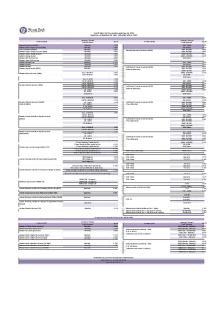
New PR - Lecture notes 3
- 1 Pages

Marketing Notes
- 91 Pages

Marketing notes
- 41 Pages

Marketing Notes
- 67 Pages

PR 10
- 48 Pages
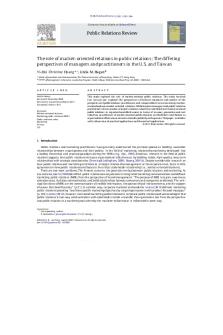
Week 2 PR Paper - Lecture notes
- 8 Pages

Penelitian PR
- 18 Pages

MANAJEMEN PR
- 17 Pages
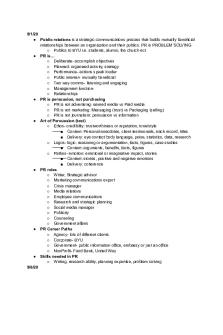
COMMS 235 intro to PR notes
- 8 Pages

Ch. 5 - PR Writing
- 3 Pages
Popular Institutions
- Tinajero National High School - Annex
- Politeknik Caltex Riau
- Yokohama City University
- SGT University
- University of Al-Qadisiyah
- Divine Word College of Vigan
- Techniek College Rotterdam
- Universidade de Santiago
- Universiti Teknologi MARA Cawangan Johor Kampus Pasir Gudang
- Poltekkes Kemenkes Yogyakarta
- Baguio City National High School
- Colegio san marcos
- preparatoria uno
- Centro de Bachillerato Tecnológico Industrial y de Servicios No. 107
- Dalian Maritime University
- Quang Trung Secondary School
- Colegio Tecnológico en Informática
- Corporación Regional de Educación Superior
- Grupo CEDVA
- Dar Al Uloom University
- Centro de Estudios Preuniversitarios de la Universidad Nacional de Ingeniería
- 上智大学
- Aakash International School, Nuna Majara
- San Felipe Neri Catholic School
- Kang Chiao International School - New Taipei City
- Misamis Occidental National High School
- Institución Educativa Escuela Normal Juan Ladrilleros
- Kolehiyo ng Pantukan
- Batanes State College
- Instituto Continental
- Sekolah Menengah Kejuruan Kesehatan Kaltara (Tarakan)
- Colegio de La Inmaculada Concepcion - Cebu

